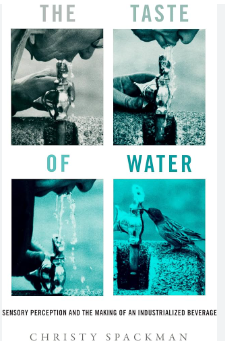Christy Spackman. The Taste of Water: Sensory Perception and the Making of an Industrial Beverage. University of California Press, 2023. 289 pages.
Food Studies scholar Christy Spackman proves that, yes, an entire book—-and a riveting one at that—-can be devoted to how water tastes, thereby explaining how it can be turned into a bland commodity with its non-taste sold at exorbitant cost.
My blurb for it:
After reading this book, I now view tasting water as just the same as tasting food, and so will you.
Here is a brief excerpt:
The tasting work done by the Nestlé team, and subsequent website and print information, paints a specific form of relationship between environment and corporation. Rather than highlighting Nestlé Waters (and one might say, all bottled water producers) as operating via extractive economies that produce PET bottles that then circulate in the environment for millennia in increasingly small particles—the tasting situated Nestlé as a core protector of the environment. Teaching dégustation meant teaching consumers to prioritize terroir, rather than the entire political economy of bottled water production….the stories that emerge through dégustation prioritize attention to long-standing understandings of the relationship between earth, food, and flavor at the expense of more recent environmental impacts of water exploitation. Attending to terroir makes it is easy to miss that the systems and ways in which bottled water is produced are, like municipal water, deeply technoscientific.
Another one:
Frankly, from a flavor perspective, for many people accustomed to the taste of bottled water, or filtered tap water, the ingestible argument DPR presents is pretty exciting. DPR [Direct Potable Reuse—i.e., reclaimed] water directly from Scottsdale’s Tap 2 completely lacks the green, musty flavors that plague so many water producers in the metropolitan Phoenix region. It tastes remarkably—or eerily—similar to many mainstream bottled water brands with its lack of minerality. Current proposals for integrating DPR into municipal water sources anticipate blending the purified effluent with treated water from the regular source. Once regulatory bodies take the step of allowing DPR, in the near future water will still slightly taste of the rivers, lakes, canals, wells, and aquifers it travelled through. Just less so.
Full disclosure: Christy Spackman is a doctoral graduate of NYU’s Food Studies program and we could not be more proud of what she has accomplished. Read her book, judge for yourself, and enjoy!
